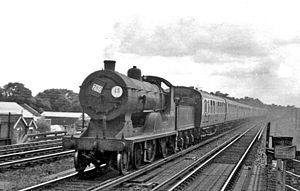LSWR D15 Class

D15 Nº 30467 heads a summer Saturday Lymington Pier to Waterloo express past West Weybridge station
|
|||||||||||||||||||||||||||||||||||
|
|||||||||||||||||||||||||||||||||||
|
|||||||||||||||||||||||||||||||||||
|
|||||||||||||||||||||||||||||||||||
|
|||||||||||||||||||||||||||||||||||
| Type and origin | |
|---|---|
| Power type | Steam |
| Designer | Dugald Drummond |
| Builder | LSWR Eastleigh Works |
| Build date | 1912–13 |
| Total produced | 10 |
| Specifications | |
|---|---|
| Configuration | 4-4-0 |
| UIC class | 2'Bh |
| Gauge | 4 ft 8 1⁄2 in (1,435 mm) |
| Leading dia. | 3 ft 7 in (1.092 m) |
| Driver dia. | 6 ft 7 in (2.007 m) |
| Length | 63 ft 9 in (19.43 m) |
| Loco weight | 59 tons, 15cwt (60.7 tonnes) (orig); 61 tons 11cwt (62.5 tonnes) (superheated version) |
| Tender weight | 49 tons 0 cwt (49.8 tonnes) (8-wheel) 36 tons 14 cwt (37.3 tonnes) (6-wheel) |
| Fuel type | Coal |
| Fuel capacity | 4 tons (4.1 tonnes) |
| Water cap | 4,500 imp gal (20,500 l) (8-wheel tender) 3,500 imp gal (15,900 l) (6-wheel tender) |
| Boiler pressure | 200 psi (1.38 MPa) (original version); 180 psi (1.24 MPa) (smoketube superheater versions.) |
| Superheater | Drummond smokebox type, later Eastleigh, later Maunsell |
| Cylinders | Two, inside |
| Cylinder size | 19½ in × 26 in (495 mm × 660 mm) 20 in × 26 in (after rebuilding) |
| Valve gear | Walschaerts |
| Performance figures | |
|---|---|
| Tractive effort | 22,333 lbf (99.34 kN) (as built), 20,100 lbf (89.41 kN) (after rebuilding) |
| Career | |
|---|---|
| Operators |
London and South Western Railway Southern Railway British Railways |
| Class | LSWR, SR & BR: D15 BR power group: 3P |
| Numbers | SR & LSWR: 463–472 BR: 30463–30472 |
| Locale | Great Britain |
| Retired | 1951–1956 |
| Disposition | All scrapped |
The LSWR D15 class 4-4-0 was the last steam locomotive design by Dugald Drummond for the London and South Western Railway in 1912. By 1912, Dugald Drummond had built several classes of unsuccessful 4-6-0 express passenger locomotives. The result of these failures was that when he designed what was to be his last class in 1911, a new 4-4-0 design emerged from Eastleigh Works in February 1912, with what was to be the first of his D15 class.
In line with the typical Drummond layout, the D15s had a short smokebox with wing plates. The boiler was based on that fitted to the 1905 rebuild of his first double-single, T7 class number 720 of 1897; and had a long firebox with a sloping grate. This resulted in the boiler being pitched higher than usual in order to allow clearance over the trailing axle.
An exhaust steam feedwater heater was provided and the boiler fed by duplex pumps located on the frames, between the coupled wheels.
The class was initially given the "intermediate" type of eight-wheel, double bogie tender with inside bogie frames carrying 4 tons (4.06 tonnes) of coal and 4,500 gallons (20.5m3), due to the lack of water troughs on the line. By 1923, the eight-wheeled tenders had been replaced by six wheeled 3,500 gallon (15.9m3) versions transferred from K10 and L11 locomotives.
After Drummond's death, Robert Urie, his successor, fitted the class with Eastleigh superheaters. These had a very small superheating surface so they were replaced by Maunsell superheaters, when Richard Maunsell was appointed Chief Mechanical Engineer of the Southern Railway after the grouping of 1923.
...
Wikipedia
